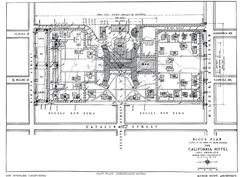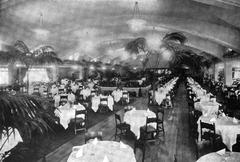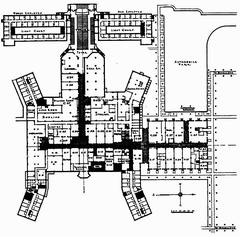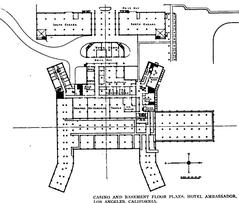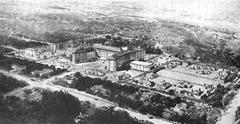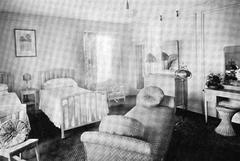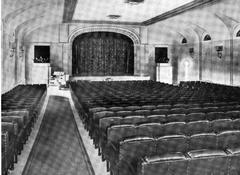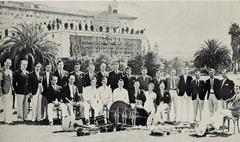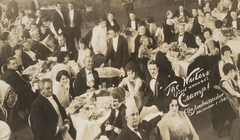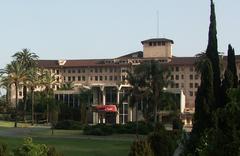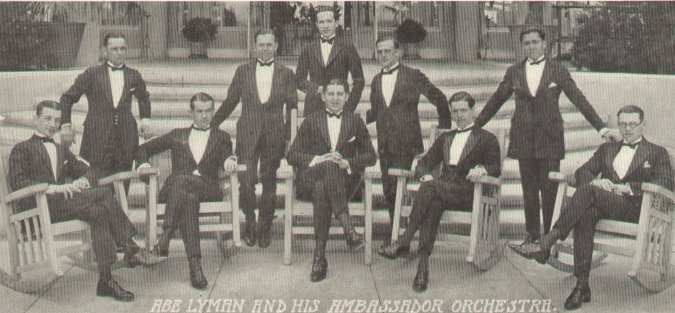
Ambassador Hotel Los Angeles: Visiting Hours, Tickets, and Historical Significance
Date: 14/06/2025
Introduction
The Ambassador Hotel once stood as a beacon of Hollywood glamour, architectural innovation, and pivotal moments in American political history. Designed by Myron Hunt and opened on January 1, 1921, its Mediterranean Revival and early Art Deco styles, lush gardens, and the legendary Cocoanut Grove nightclub made it a magnet for celebrities and dignitaries. But the hotel’s story also includes periods of decline, a defining national tragedy, and an eventual rebirth as the Robert F. Kennedy Community Schools. Though the original building no longer exists, the site remains a touchstone for Angelenos and history enthusiasts, blending commemoration with community renewal (PBS SoCal; Academy Museum).
This guide explores the Ambassador Hotel’s rich history, cultural impact, what visitors can experience at the site today, and practical information for those wishing to connect with its enduring legacy.
Table of Contents
- Origins & Architectural Significance
- Hollywood Glamour: The Cocoanut Grove
- Turning Point: The RFK Assassination & Decline
- Preservation, Demolition, and Community Rebirth
- Visiting the Site: Hours, Access & Tips
- Nearby Attractions
- Film & Pop Culture Legacy
- Frequently Asked Questions
- Summary & Visitor Recommendations
- References
Origins & Architectural Significance
The Ambassador Hotel was conceived during a period of rapid Los Angeles expansion. Myron Hunt’s design embodied the city’s ambition, blending Mediterranean Revival and early Art Deco elements. When it opened on what was then a remote stretch of Wilshire Boulevard, the hotel and its 23.5 acres of gardens, tennis courts, and recreational facilities set new standards for luxury hospitality (PBS SoCal). The development helped transform Wilshire Boulevard into a vital artery of Los Angeles life, shaping the growth and identity of the city.
Hollywood Glamour: The Cocoanut Grove
A few months after its grand opening, the Cocoanut Grove nightclub debuted, immediately becoming an epicenter of Hollywood nightlife. Its palm trees—originally props from “The Sheik”—and lush décor attracted luminaries like Frank Sinatra, Judy Garland, and Sammy Davis Jr. The club hosted six Academy Awards ceremonies between 1930 and 1943, anchoring the hotel’s place in cinematic history (LA Almanac; Vickie Lester). The Ambassador’s guest list also included U.S. presidents, foreign leaders, and world-famous entertainers.
Turning Point: The RFK Assassination & Decline
On June 5, 1968, the Ambassador became the site of a national tragedy: Senator Robert F. Kennedy was assassinated in the hotel’s kitchen pantry after winning the California Democratic primary (PBS SoCal). The event indelibly marked the hotel’s legacy, transforming it from a symbol of celebration to one of reflection and mourning.
In the years that followed, the Ambassador struggled to recapture its former glory. Urban shifts, unsuccessful modernization attempts, and a changing social landscape led to the hotel’s closure in 1989. By then, large portions of the property were abandoned or shuttered, and the surrounding area experienced significant decline.
Preservation, Demolition, and Community Rebirth
Despite passionate efforts by the Los Angeles Conservancy and preservationists, the hotel’s fate was sealed after protracted legal battles. Decades of neglect and unsympathetic renovations weakened its architectural integrity (NY Times Archive). After the Los Angeles Unified School District acquired the site by eminent domain, demolition began in 2005, sparing only select features like the Cocoanut Grove’s east wall (LA Times; Vickie Lester).
The site’s transformation into the Robert F. Kennedy Community Schools, opened in 2010, represents a unique blend of remembrance and renewal. The campus incorporates preserved elements, including the Cocoanut Grove auditorium and memorial installations, ensuring the hotel’s history endures (Wikipedia).
Visiting the Site: Hours, Access & Tips
Location: 3400 Wilshire Boulevard, Los Angeles, CA 90010 (Koreatown)
- Inspiration Park: The Robert F. Kennedy Inspiration Park, at Wilshire and Catalina, is open daily during daylight hours with free entry. It features a bronze bust of Kennedy, interpretive panels, and art installations (Daveland Blog).
- School Campus: The Robert F. Kennedy Community Schools is an active educational complex. Public access is restricted; however, the Cocoanut Grove auditorium’s exterior and select commemorative plaques are viewable from public areas.
- Guided Tours: Occasionally, special events or guided tours offer access to the interior historic spaces. Check the RFK Schools website or contact local historical organizations for updates.
- Accessibility: The site is accessible by Metro (Wilshire/Normandie or Wilshire/Vermont stations) and bus. Parking is limited; public transit is recommended.
- Etiquette: Respect school operations, avoid restricted areas, and observe posted guidelines. Photography is welcome in the park and exterior areas.
Nearby Attractions
- Koreatown: Known for vibrant dining, nightlife, and diverse cultural experiences.
- Wiltern Theatre: A historic Art Deco music venue just blocks away.
- MacArthur Park: A classic urban park nearby.
- Other Landmarks: Consider visiting the Hollywood Roosevelt, Millennium Biltmore, and Beverly Wilshire hotels for more Hollywood history.
Film & Pop Culture Legacy
The Ambassador Hotel and Cocoanut Grove were featured in iconic films such as “The Graduate,” “Forrest Gump,” and “Bobby.” Its distinctive architecture and glamorous history made it a sought-after filming location and a symbol of Los Angeles’ golden era (TheAmbassadorHotel.com).
Frequently Asked Questions
Q: Can I visit the original Ambassador Hotel?
A: The hotel was demolished in 2005–2006. Visitors can experience the site’s legacy through the Robert F. Kennedy Inspiration Park and commemorative features around the school campus.
Q: Is there an admission fee or ticket required?
A: No fee or ticket is required to visit the public areas. Special events or guided tours may require prior registration.
Q: Are there official tours of the site?
A: There are no routine tours, but local historical societies and the Los Angeles Conservancy sometimes include the site in walking tours.
Q: Is the site accessible for visitors with disabilities?
A: Yes, public areas and sidewalks are wheelchair accessible.
Q: Are photos allowed?
A: Photography is welcome in Inspiration Park and exterior areas. Interior photography is only allowed during authorized tours or events.
Summary & Visitor Recommendations
Though the Ambassador Hotel no longer graces Wilshire Boulevard, its influence endures in Los Angeles’ cultural memory and urban landscape. From its inception as a luxury landmark and the heart of Hollywood’s golden age to its role in national tragedy and community transformation, the Ambassador’s story is one of both grandeur and resilience (PBS SoCal; Academy Museum; LA Times).
Visitors can reflect on its past at the Robert F. Kennedy Inspiration Park, explore Koreatown, and connect with the city’s heritage through walking tours and digital archives. For a deeper dive, utilize resources like the Los Angeles Conservancy and the Academy Museum’s collections.
For those seeking to experience Los Angeles’ layered history, the Ambassador Hotel site offers a compelling blend of remembrance and renewal. Download the Audiala app for guided tours, follow heritage channels for updates, and explore nearby cultural landmarks to enrich your visit.
References
- PBS SoCal – Lost LA: The Ambassador Hotel
- Academy Museum – Ambassador Hotel
- Daveland Blog – Remnants of the Ambassador
- Los Angeles Conservancy – Ambassador Hotel (Demolished)
- LA Times – Ambassador Hotel Demolition and RFK Schools
- TheAmbassadorHotel.com
- Wikipedia – Ambassador Hotel (Los Angeles)
- Vickie Lester – The Ambassador Hotel
- LA Almanac – Ambassador Hotel and Cocoanut Grove
- Time Out LA – Things You Should Know About LA Before Visiting
- TravelCaffeine – Los Angeles Guide

